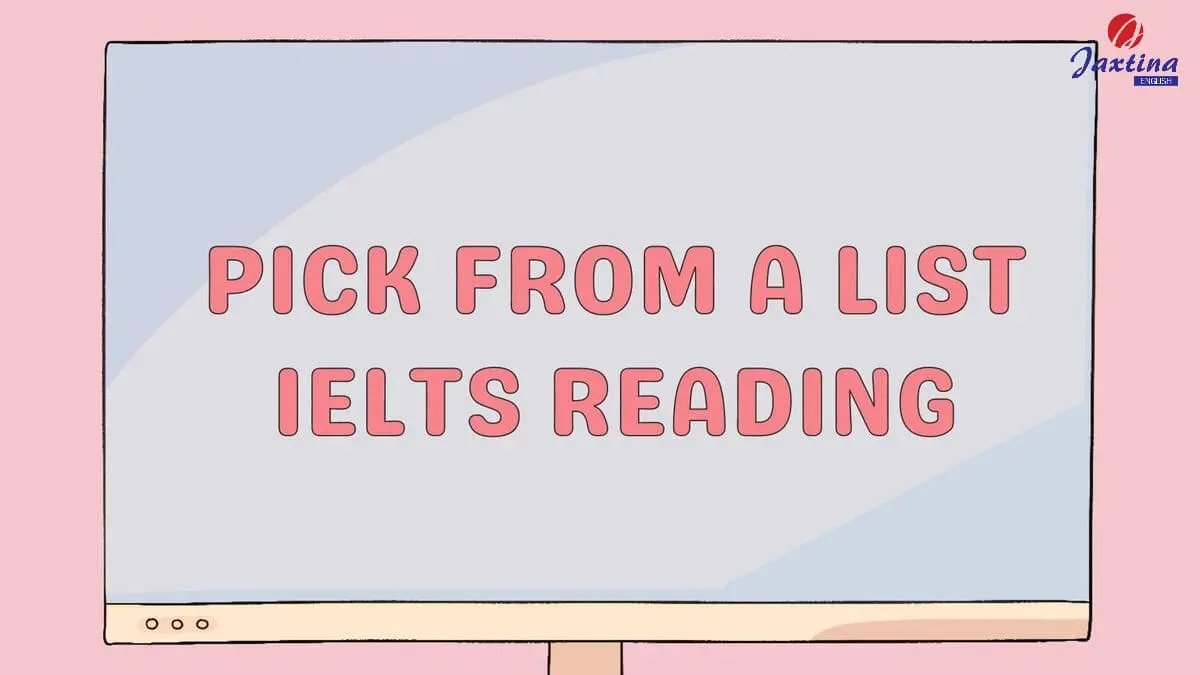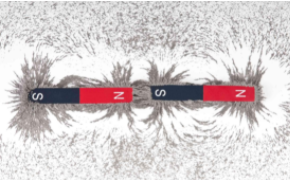

Cách làm Pick from a list IELTS Reading và lưu ý cần nhớ

 20.10.2023
20.10.2023
 6 phút đọc
6 phút đọc 1342 lượt xem
1342 lượt xem
Dạng bài Pick from a list IELTS Reading là một dạng bài khá ít thấy trong bài thi Reading và đồng thời cũng có nét tương đồng với Multiple Choices. Tuy được đánh giá là “dễ thở” hơn so với Multiple Choices nhưng dạng bài này cũng gây không ít khó khăn cho các bạn nếu không nắm được chiến thuật làm bài đúng đắn. Do đó, trong bài viết dưới đây, Jaxtina sẽ chia sẻ đến bạn phương pháp làm dạng bài trên và một số lưu ý cần nhớ về dạng bài này khi học IELTS. Hãy xem ngay nhé!
1. Tips làm dạng bài Pick from a list Reading IELTS
Sau đây là một số phương pháp làm dạng bài Reading này mà bạn nên ghi nhớ để luyện tập trong quá trình luyện thi IELTS:
- Đọc câu hỏi và danh sách đáp án.
- Xác định keyword của câu hỏi và cách viết câu của các đáp án.
- Hiểu thông tin và mối liên hệ giữa chúng với nhau.
- Ghép các từ khóa với các từ có trong bài văn, vì vậy bạn có thể tìm đúng vị trí chính xác cho câu trả lời.
Hiện trung tâm Jaxtina English Center đang có nhiều chương trình ưu đãi học phí khi đăng ký combo 2 khóa học trở lên cũng nhiều khuyến mãi khác. Điền ngay thông tin vào form bên dưới để đăng ký nhận thông tin chi tiết về chương trình ưu đãi nhé!
Tìm Hiểu Chi Tiết: Các dạng bài Reading IELTS và cách làm
2. Lưu ý khi làm Pick from a list IELTS Reading
Khi làm dạng bài này, bạn cần lưu ý các vấn đề sau đây:
- Các ý sẽ thường đi theo thứ tự từ trên xuống
- Các câu sẽ thường được paraphrase lại (để gây khó khăn hơn cho việc tìm đáp án đúng), nhưng không phải luôn luôn
- Sẽ có nhiều ý để đánh lạc hướng chúng ta
Xem Thêm: Cách luyện Reading IELTS hiệu quả
3. Bài tập vận dụng tips làm Pick from a list
Bây giờ, hãy thử áp dụng các tips trên vào bài tập mẫu dưới đây về dạng bài này khi học IELTS cho người mới bắt đầu.
Practice. Read the passage and do the following task below. (Đọc bài viết và làm theo yêu cầu dưới đây.)
Questions 11-13: Choose THREE letters A-F. Which THREE of the following are parts of Gilbert’s discovery?
|
William Gilbert and Magnetism A. The 16th and 17th centuries saw two great pioneers of modern science: Galileo and Gilbert. The impact of their findings is eminent. Gilbert was the first modern scientist, also the accredited father of the science of electricity and magnetism, an Englishman of learning, and a physician at the court of Elizabeth. Prior to him, all that was known of electricity and magnetism was what the ancients knew, nothing more than that the lodestone possessed magnetic properties and that amber and jet, when rubbed, would attract bits of paper or other substances of small specific gravity. However, he is less well-known than he deserves. B. Gilbert’s birth pre-dated Galileo. Born in an eminent local family in Colchester County in the UK, on May 24, 1544, he went to grammar school and then studied medicine at St John’s College, Cambridge, graduating in 1573. Later he travelled in the continent and eventually settled down in London. C. He was a very successful and eminent doctor. All this culminated in his election to the president of the Royal Science Society. He was also appointed personal physician to the Queen (Elizabeth I), and later knighted by the Queen. He faithfully served her until her death. However, he didn’t outlive the Queen for long and died on November 30, 1603, only a few months after his appointment as personal physician to King James. D. Gilbert was first interested in chemistry but later changed his focus due to the large portion of mysticism of alchemy involved (such as the transmutation of metal). He gradually developed his interest in physics after the great minds of the ancient, particularly about the knowledge the ancient Greeks had about lodestones, strange minerals with the power to attract iron. In the meantime, Britain became a major seafaring nation in 1588 when the Spanish Armada was defeated, opening the way to British settlement of America. British ships depended on the magnetic compass, yet no one understood why it worked. Did the Pole Star attract it, as Columbus once speculated; or was there a magnetic mountain at the pole, as described in Odyssey, which ships would never approach, because the sailors thought its pull would yank out all their iron nails and fittings? For nearly 20 years, William Gilbert conducted ingenious experiments to understand magnetism. His works include On the Magnet, Magnetic Bodies, and the Great Magnet of the Earth. E. Gilbert’s discovery was so important to modern physics. He investigated the nature of magnetism and electricity. He even coined the word “electric”. Though the early beliefs of magnetism were also largely entangled with superstitions such as that rubbing garlic on lodestone can neutralise its magnetism, one example being that sailors even believed the smell of garlic would even interfere with the action of compass, which is why helmsmen were forbidden to eat it near a ship’s compass. Gilbert also found that metals can be magnetised by rubbing materials such as fur, plastic or the like on them. He named the ends of a magnet “north pole” and “south pole”. The magnetic poles can attract or repel, depending on polarity. In addition, however, ordinary iron is always attracted to a magnet. Though he started to study the relationship between magnetism and electricity, sadly he didn’t complete it. His research of static electricity using amber and jet only demonstrated that objects with electrical charges can work like magnets attracting small pieces of paper and stuff. It is a French guy named du Fay that discovered that there are actually two electrical charges, positive and negative. F. He also questioned the traditional astronomical beliefs. Though a Copernican, he didn’t express in his quintessential beliefs whether the earth is at the centre of the universe or in orbit around the sun. However, he believed that stars are not equidistant from the earth but have their own earth-like planets orbiting around them. The earth itself is like a giant magnet, which is also why compasses always point north. They spin on an axis that is aligned with the earth’s polarity. He even likened the polarity of the magnet to the polarity of the earth and built an entire magnetic philosophy on this analogy. In his explanation, magnetism is the soul of the earth. Thus a perfectly spherical lodestone, when aligned with the earth’s poles, would wobble all by itself in 24 hours. Further, he also believed that the sun and other stars wobble just like the earth does around a crystal core, and speculated that the moon might also be a magnet caused to orbit by its magnetic attraction to the earth. This was perhaps the first proposal that a force might cause a heavenly orbit. |
A. Metal can be transformed into another.
B. Garlic can remove magnetism.
C. Metals can be magnetized.
D. Stars are at different distances from the Earth.
E. The earth wobbles on its axis.
F. There are two charges of electricity.
Xem đáp án
- C. Metals can be magnetised. Dựa vào cụm từ khóa của câu cho sẵn “Metals” (Một số kim loại), “can be magnetised” (có thể bị nhiễm từ) và đoạn trong bài đọc liên quan đến 2 cụm từ khóa này “Gilbert also found that metals can be magnetised by rubbing materials such as fur, plastic or the like on them.” nghĩa là “Gilbert cũng tìm ra được rằng kim loại có thể bị nhiễm từ bằng cách cọ xát với các vật liệu như lông thú, nhựa hoặc những thứ tương tự lên chúng.” để xác định đáp án là C. Metals can be magnetised.
- D. Stars are at different distances from the Earth. Dựa vào cụm từ khóa của câu cho sẵn “Stars” (Các ngôi sao), “at different distances from the earth” (ở các khoảng cách khác nhau so với Trái Đất) và đoạn trong bài đọc liên quan đến 2 cụm từ khóa này “However, he believed that stars are not equidistant from the earth but have their own earth-like planets orbiting around them.” nghĩa là “Tuy vậy, ông tin rằng các ngôi sao không cách đều trái đất mà là có cho mình một quỹ đạo riêng với những hành tinh tương tự như Trái Đất quay quanh.” để xác định đáp án là D. Stars are at different distances from the earth. Trong câu này, “are not equidistant from the earth” được diễn đạt lại thành “at different distances from the earth”.
- E. The earth wobbles on its axis. Dựa vào cụm từ khóa của câu cho sẵn “The earth” (Trái Đất), “wobbles” (ngả), “its axis” (trục quay của nó) và đoạn trong bài đọc liên quan đến 2 cụm từ khóa này “The earth itself is like a giant magnet, which is also why compasses always point north. They spin on an axis that is aligned with the earth’s polarity. (…) Further, he also believed that the sun and other stars wobble just like the earth does.” nghĩa là “Bản thân Trái Đất giống như một cục nam châm khổng lồ, đó là lí do vì sao kim la bàn luôn chỉ về hướng Bắc. Chúng quay trên một trục cùng phương với cực Trái Đất. (…) Do vậy, ông cũng tin rằng mặt trời và các ngôi sao khác đều ngả theo trục giống như Trái Đất.” để xác định đáp án là E. The earth wobbles on its axis. Trong câu này, “an axis that is aligned with the earth’s polarity” được diễn đạt lại thành “its axis”.
Một số từ vựng hay trong bài đọc!
| Từ vựng | Phiên âm | Nghĩa tiếng Việt |
| wobble on (v.p) | /ˈwɑbəl ɑn/ | ngả, nghiêng theo |
| align with (v.p) | /əˈlaɪn wɪð/ | sắp thẳng hàng |
| at a distance (prep.p) | /æt ə ˈdɪstəns/ | ở một khoảng cách |
| eminent (adj) | /ˈɛmənənt/ | nổi tiếng, xuất sắc, đức độ |
| equidistant (adj) | /ˈiːkwɪˈdɪstənt/ | cách đều |
Trên đây là những chia sẻ về chiến lược làm dạng bài pick from a list IELTS Reading. Và nếu bạn vẫn còn bối rối không biết nên làm như thế nào, hãy đến với khoá luyện thi Jaxtina English Center. Các giáo viên tại đây sẽ hướng dẫn bạn làm bài thật chi tiết. Liên hệ đến 1900 63 65 64 để được hỗ trợ nhé!
Bài Viết Hữu Ích:
- 200+ từ vựng IELTS Reading theo chủ đề thường gặp nhất
- IELTS Reading – Tổng hợp các SYNONYMS thường gặp trong bộ Cam huyền thoại
Bài viết cùng chuyên mục

 24.11.2025
24.11.2025 13 phút đọc
13 phút đọc 4971 xem
4971 xem
Bằng IELTS 6.5 cao hay thấp, được tuyển thẳng đại học nào?

 24.11.2025
24.11.2025 18 phút đọc
18 phút đọc 2733 xem
2733 xem
Học IELTS General ở đâu? 6 trung tâm dạy IELTS General chất…

 24.11.2025
24.11.2025 17 phút đọc
17 phút đọc 2860 xem
2860 xem
Học IELTS 1 kèm 1 Có Nên Không? Giải pháp học cá…

-
Đăng ký thông tin:Điền thông tin liên hệ và lựa chọn cơ sở Jaxtina gần nhất
-
Đặt lịch hẹn:Tư vấn viên sẽ gọi lại bạn để xác nhận thông tin & mục tiêu học tập của bạn
-
Xây dựng lộ trình cá nhân hoá:Đến trung tâm và tham gia kiểm tra trình độ miễn phí. Bài kiểm tra sẽ giúp xác định chính xác lộ trình và thời gian bạn đạt mục tiêu
-
Bắt đầu:Bắt đầu hành trình thay đổi tương lai của bạn
Để giúp bạn lựa chọn khoá học phù hợp,
tối ưu thời gian và chi phí nhất,
bạn hãy điền chính xác các thông tin bên dưới nhé!
ĐĂNG KÝ THI THỬ IELTS
Để giúp bạn xác định được band điểm IELTS hiện tại và lựa chọn lịch thi phù hợp, hãy điền chính xác thông tin đăng ký bên dưới nhé!
Đăng ký thành công
Jaxtina đã nhận thông tin đăng ký của bạn.


 Tư vấn nhanh
Tư vấn nhanh
 Chat tư vấn
Chat tư vấn
 Chat Messenger
Chat Messenger
 Chat Zalo
Chat Zalo
 +1900 63 65 64
+1900 63 65 64